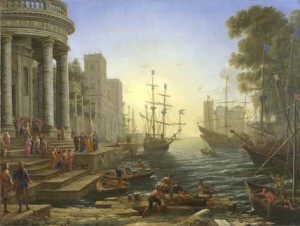PREVIOUS: REMBRANDT – THE WOMAN TAKEN IN ADULTERY
Seaport with the embarkation of St Ursula: Claude: 1641
We’re looking at an imaginary landscape, at a place that doesn’t exist. Some of the buildings are based on real buildings, but they’re being used here almost like set decoration, to provide a perfect composition.
The sun is just rising and bathes the scene in a wonderful early morning light., and the eye is led to the centre of the picture by the brightness of the sun and the lines of buildings on the left and of the ships on the right.
From the temple on the left come dozens of women, some with children, some carrying bows and arrows, and they are coming down the steps to get onto these small boats which will take them out to the ships in the harbour. In the foreground a group of sailors are loading up luggage, again to transfer it to the sailing ships.
The artist of this painting, Claude, loved painting landscapes, but at this time landscape pictures were thought of as being an inferior type of art, so Claude put an historical or mythological context on his works so that they became ‘history’ paintings, which were more highly regarded. (Although Claude used to tell clients that they paid for the landscape and that he supplied the figures free.)
The story that Claude uses here is the legend of St Ursula. She was supposedly the Christian daughter of a 4th century British king who was betrothed to a pagan prince. She agreed to marry him on the condition that he allowed her to go on pilgrimage to Rome accompanied by 11,000 virgins. They returned from Rome by way of Cologne where they were all slaughtered by the Huns – Ursula being shot through the heart with an arrow.
Other artists have painted the story, but they concentrated on the more violent parts of it. This wasn’t important to Claude – the legend to him was an excuse to paint the scenery and the light.
So he gives us the moment when Ursula is leaving Rome. We can see her on the quayside on the left, dressed in an orange robe and holding the flag of St George, and the bows and arrows symbolise the martyrdom. Given that they’re all meant to be virgins, I’m not sure where the children come from.
Few other painters have managed to paint the effect of this amazingly soft, glowing light. Claude always depicts either dawn or twilight, calling them the most poetic times of day.
This use of light and landscape inspired Turner, and John Constable described Claude as “the most perfect landscape painter the world ever saw”. Later in our tour we’ll look at paintings by both these artists and you will see his influence on these two.
Another artist who loved landscape painting was Rubens, and that’s the next artist we’ll look at.


